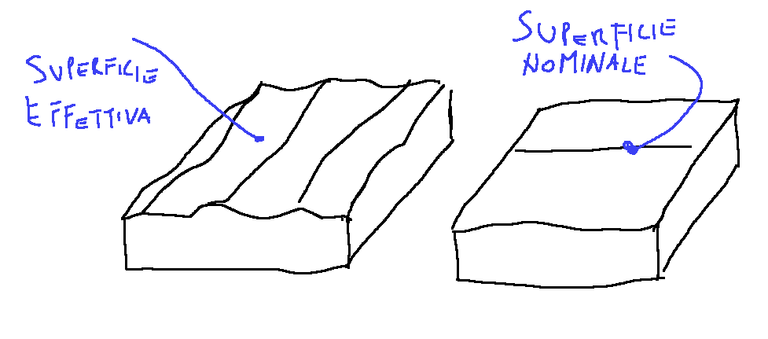13-12-2023 - Mechanical Drawing - Machining and roughness [EN]-[IT]

~~~ La versione in italiano inizia subito dopo la versione in inglese ~~~
ENGLISH
13-12-2023 - Mechanical Drawing - Machining and roughness [EN]-[IT]
Works
To obtain a finished price, several processing phases must be carried out. These processing phases allow us to move from the raw material to the semi-finished products to then arrive at the final shape and dimensions of the component.
The manufacturing processes can be identified in five fields.
These five processes are forming, deformation, removal, joining and heat and surface treatment.
In mechanical parts, one of the most used processes is turning. In this process, the workpiece is fixed to the rotating part of a machine, while the tool is fixed to the mobile longitudinal and transversal transmission part.
The other process that is important in the mechanical field is milling. The tool, i.e. the cutter, is equipped with cutting edges arranged symmetrically around an axis, rotates and removes the chip from the piece fixed to the surface.
Roughness
We must always keep in mind that the shapes and dimensions represented in the drawing are ideally perfect, that is, they are nominal dimensions.
So as far as manufacturing errors are concerned, there are geometric errors. These geometric errors can be divided into two categories: micro geometric errors and macro geometric errors.
To try to contain micro geometric errors we rely on roughness.
Roughness means the micro deviation of the shape of the actual surfaces compared to the shape of the nominal surfaces. This is caused by the action of the tools.

The roughness parameters are different. Below I mention some of them.
Ra - average roughness parameter.
Ra is the arithmetic mean of the absolute values of the profile deviations from the mean line.
Ra represents the area subtended by the roughness profile. Bear in mind that a lower value of Ra corresponds to a smoother surface.
The roughness parameter Ra is the most used parameter and can be measured with unsophisticated instruments.
However, this parameter has some disadvantages. Ra is an index of the surface finish independent of the type of grooves. This may not give the correct data for making a surface that holds lubricant. It may happen that surfaces with the same Ra value have a different mechanical functionality.
Conclusions
To limit micro geometric errors we have the possibility, in the technical drawings, to indicate the roughness.

ITALIAN
13-12-2023 - Disegno Meccanico - Lavorazioni e rugosità [EN]-[IT]
Lavorazioni
Per ottenere un prezzo finito occorre eseguire più fasi di lavorazione. Queste fasi di lavorazione permettono di passare dal materiale grezzo ai semilavorati per arrivare poi alla forma e alle dimensioni definitive del componente.
I processi di lavorazione si possono identificare in cinque campi.
Queste cinque lavorazioni sono la formatura, la deformazione, l’asportazione, l’unione e il trattamento termico e superficiale.
Nei pezzi meccanici una delle lavorazioni più usate è la tornitura. In questa lavorazione il pezzo da lavorare viene fissato alla parte girevole di una macchina, mentre l’utensile è fissato alla parte mobile di trasmissione longitudinale e trasversale.
L’altra lavorazione che è importante nel campo meccanico è la fresatura. L’utensile, cioè la fresa, è munito di taglienti disposti simmetricamente intorno ad un asse, ruota ed asporta il truciolo dal pezzo fissato al piano.
Rugosità
Dobbiamo sempre tener presente che le forme e le dimensioni rappresentate nel disegno sono idealmente perfette, cioè sono dimensioni nominali.
Quindi per quanto riguarda gli errori di lavorazione esistono appunto gli errori geometrici. Questi errori geometrici si possono racchiudere in due categorie: errore micro geometrici ed errori macro geometrici.
Per cercare di contenere gli errori micro geometrici ci affidiamo alla rugosità.
Per la rugosità si intende il micro scostamento della forma delle superfici effettive rispetto alla forma delle superfici nominali. Questo è provocato dall’azione degli utensili.

I parametri di rugosità sono diversi. Qui di seguito ne cito alcuni.
Ra - parametro di rugosità media.
Ra è la media aritmetica dei valori assoluti degli scostamenti del profilo dalla linea media.
Ra rappresenta l'area sottesa dal profilo di rugosità. Si tenga presente che ad un minore valore di Ra corrisponde una superficie più liscia.
Il parametro di rugosità Ra è il parametro più usato e si può misurare con strumenti non sofisticati.
Questo parametro però ha alcuni svantaggi. Ra è un indice della finitura superficiale indipendente dal tipo di solchi. Questo potrebbe non dare un dato corretto al fine di realizzare una superficie che trattenga del lubrificante. Può accadere che superfici con lo stesso valore di Ra abbiano una diversa funzionalità meccanica.
Conclusioni
Per confinare gli errori micro geometrici abbiamo la possibilità, nei disegni tecnici, di indicare la rugosità.
THE END
I always prefer people to do some tough work before transferring it to the main work template
I agree with this step that should always be taken
Now that the lines do not look straight, were they also measured or not?
There are instruments that can measure surface imperfections that would be invisible to the naked eye
Ebbene, i tuoi post relativi a questi argomenti sono senza dubbio interessanti. Ti auguro una felice giornata
La rugosità delle superfici è una delle cose che ho sempre fatto fatica a comprendere, soprattutto i vari indici di misurazione